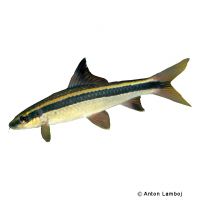Siamese Flying Fox (Crossocheilus oblongus)
| Siamese Flying Fox Crossocheilus oblongus | |
|---|---|
| Name | Siamese Flying Fox |
| Name Lat. | Crossocheilus oblongus |
| Synonym | Epalzeorhynchos siamensis |
| Family | Carps |
| Family lat. | Cyprinidae |
| Order | Carps |
| Order lat. | Cypriniformes |
| Origin | Southeast Asia |
| Habitat | Tributaries, streams |
| Diet | Omnivore |
| pH | 6.0-7.5 |
| Behavior | Peaceful |
| Keeping | Group |
| Care Level | Easy |
| Reproduction | Oviparous |
| Breeding | None reported |
| Life Span | 5-10 years |
| Protection | No |
| Metric Units | |
| Size | 10-14 cm |
| Temperature | 20-26 °C |
| Hardness | 1-15 °dH |
| Aquarium | 100 cm / 200 l |
| US Units | |
| Size | 3.9"-5.5" |
| Temperature | 68-79 °F |
| Hardness | 18-267 ppm |
| Aquarium | 50 gal |
Distribution and habitat
The distribution area of the Siamese snout barb is Thailand and the Malay Peninsula. They live there in the shallow waters of tributaries and streams with tree roots and dead wood, and soils covered with gravel and stones.
Maintenance
The aquarium should have a robust border planting, with numerous hiding places (roots, stones, caves) and a substrate of round gravel and sand. A slight current is ideal.
No ammonia, ammonium and nitrite should be detectable, the nitrate value should not exceed 100 mg/l. To ensure the water quality and oxygen content, a filter and heater adapted to the aquarium size is required, as well as lighting for the species-appropriate day-night rhythm of the animals.
Diet
They eat the plant cover (growth) of stones, wood, plants, etc. and the microorganisms contained therein. In addition, algae leaves, blanched peas and zucchini, scalded leaves (spinach, dandelion) and dry food (pellets, tablets) with high vegetable content (spirulina, kelp) should be offered. In addition, some live food such as mosquito larvae, cyclops and daphnia, which is also accepted in frozen form.
A regular and varied diet promotes health and prevents deficiency symptoms. Only as much should be fed as is eaten immediately (in a maximum of 10 minutes).
Behaviour and compatibility
They are peaceful towards other, even smaller fish and can be kept well in a community tank. Among each other it can occasionally come to territorial disputes. At least 5 Siamese Snout Barbs should be kept together.
In principle, only mutually compatible fish species with similar requirements to the water condition and water temperature may be socialized.
Sex dimorphism
The sexes have no external distinguishing characteristics. Adult males are slightly more slender than females
Reproduction and breeding
There are no known reports of successful breeding in the aquarium.
Important
They are very good algae eaters, grazing even the turf of the beard alga. However, fine finned plants also serve them as food
The Siamese Snout Barb is often confused with the Fairfin Snout Barb (Epalzeorhynchos kalopterus), which hardly eats algae. The Siamese snout barbs have red and black colored fins and a white fin fringe, which the Siamese snout barbs lack
The well-being of the fish should be monitored regularly. Temperature should be checked daily, pH, hardness and nitrate levels at least every 14 days. Regular partial water changes are recommended, even if the contaminant level has not yet reached the upper limit. Sudden changes in water quality should be avoided. Newly introduced fish must be accustomed slowly to the water in the aquarium.
Further literature can be found in your pet store.
References
Text: Sabina Lamboj; Image: Anton Lamboj
Source: BMELV (1998): Tierschutzgutachten - Haltung von Zierfischen (Süßwasser); RIEHL & BAENSCH (2006): Aquarien Atlas Bd. 1, Mergus Verlag; ENGELMANN (2005): Zootierhaltung - Tiere in menschlicher Obhut: Fische, Verlag Harri Deutsch
- Gemäß § 21 Abs. 5 Tierschutzgesetz idgF
